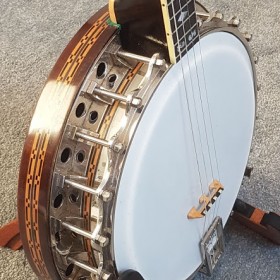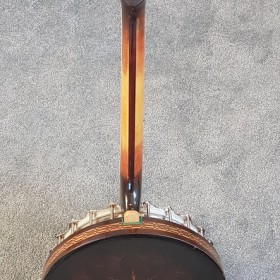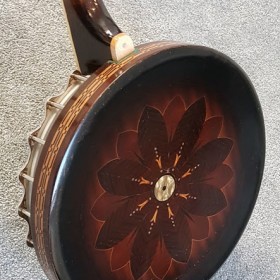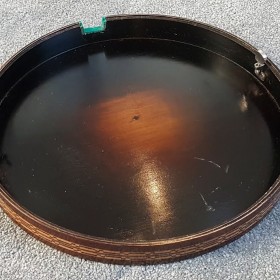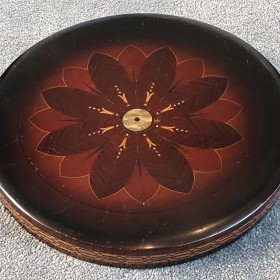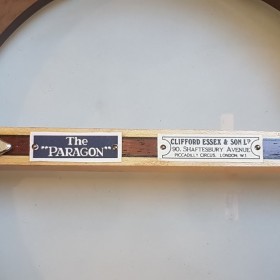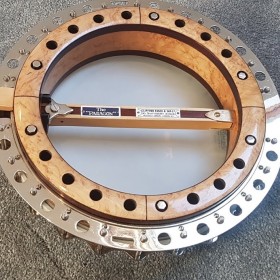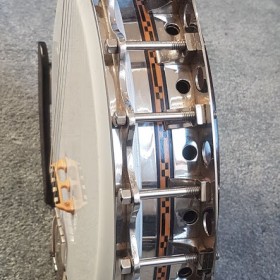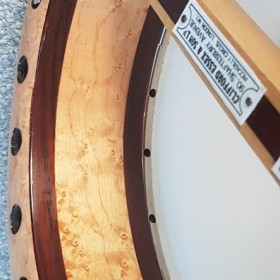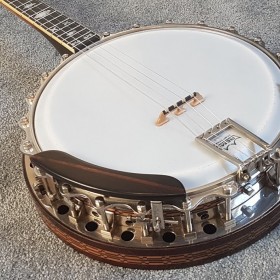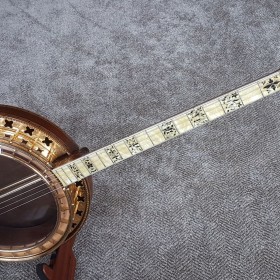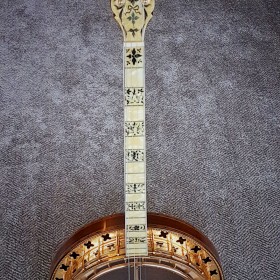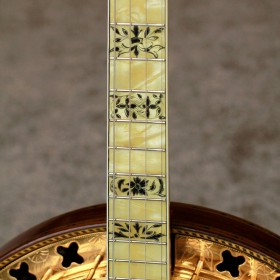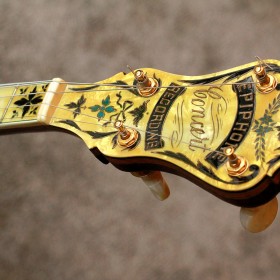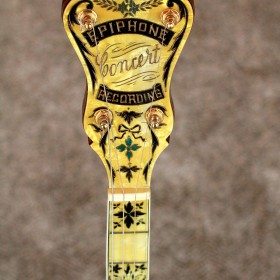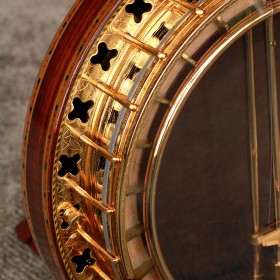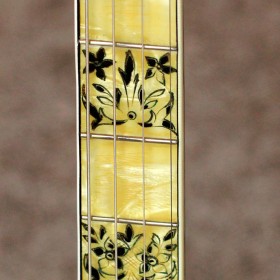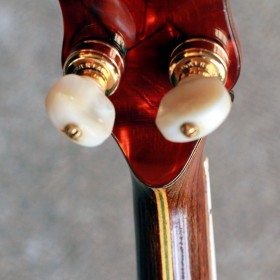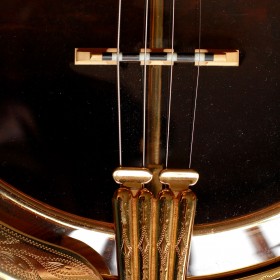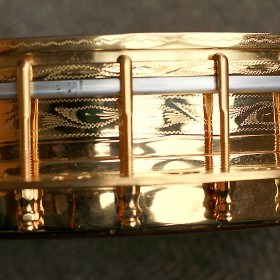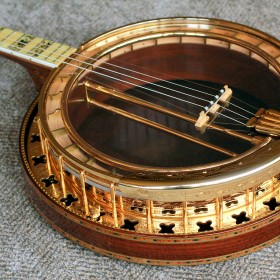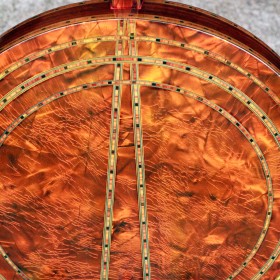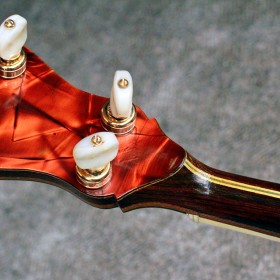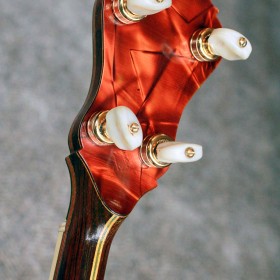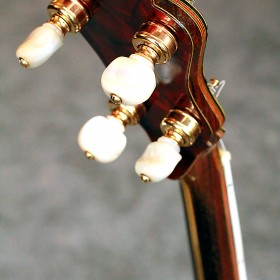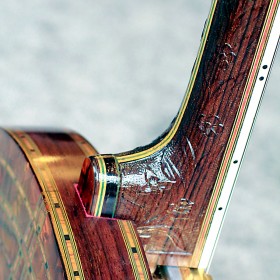An exquisite, very beautiful 1930 Epiphone Concert tenor banjo. Gold plating throughout in pristine condition, made frombrazilian rosewood, fully setup for professional level playing…
Banjo details
The following information has been drawn from the early 1930’s Epiphone catalogue. The neck is made from lustrous Brazillian Rosewood, the fingerboard is of multiply construction faced with mother of pearl Pyralin. The Pyralin on the fingerboard and head plate is hand engraved and tinted in multicolour floral designs. The wood heel of the neck is hand carved in a beautiful design of flowers and leaves. The resonator is faced with gleaming amber tortoise shell Pyralin inset with innumerable lines of coloured wood marquetry, both around and across the resonator.
The original Grover Deluxe 4-1 gear tuners are all working perfectly and holding tune and the peg buttons are genuine mother of pearl of the finest quality. All of the metal work throughout is in excellent condition, beautifully hand engraved and quadruple gold plated. Grover Deluxe tailpiece with spring cover and adjustment screw, and engraved Epiphone armrest. Set up with new Remo clear head, new strings and new bridge.
Comes with a choice of new hardshell flight case or restored vintage case.
Sold
A little bit of history
In 1931 the Epiphone Company introduced a new Masterbuilt guitar series to effectively rebrand the company as a giant of the guitar world, this was due to the demise of the popularity of the tenor banjo. Just as Epiphone launched the Masterbuilt series around the dawn of the modern archtop guitar, they launched the Recording series around the dawn of the modern tenor and plectrum banjo. In 1934 the catalogue was still attributed to the Epiphone Banjo Corporation on the cover.
The company’s previous models had been solid enough instruments, but they were relatively mundane in terms of appearance. The Recording series changed all that, making extensive use of pearloid, sparkling Pyralin and engraving. The initial lineup in 1925 was (roughly) alphabetized: Artist, Bandmaster, Concert Art, Deluxe Art, and Emperor from least to most expensive. A few other models, including the Alhambra, Dansant and Concert Special were added in 1927, about the same time that the Concert Art and Deluxe Art were simplified into the Concert and Deluxe models. The “Art” series made extensive use of pearl inlays, with engraved dragons on the headstocks; their replacements relied heavily on engraved and painted pyralin to provide a flashy appearance.
The Concert sat in the middle of the Recording line, but as the entire range was aimed at professional players, it bore all the trademarks of a high-end banjo. The neck was made of Brazilian rosewood with a 3-layer center lamination for stiffness, and the heel was carved with a floral pattern. Like the rest of the Recording series, the rim was made of walnut (a material uniquely favored by Epiphone in the ’20s and ’30s). The hardware was all plated in gold. The Concert Special was structurally similar but featured a holly neck and lighter-colored pyralin veneers to match. Both listed for $300, though the price was up to $330 by the early 1930s. Minor cosmetic changes occurred often to both models, and it appears that Epiphone regarded catalogue specifications more like suggestions than hard and fast rules.
Like all the Recording series, the Concert had an archtop tone ring. By narrowing the vibrating surface of the head, this style of construction produces a bright sound that may be relatively light on bass but can cut through a band with ease. By retaining a full-size rim and resonator, the banjo maintains considerable volume. The Epiphone catalog also emphasized the single-piece flange whose L-shaped cross section was intended to stiffen and support the rim. The catalog also noted the bar of “specially tempered surgical steel” that acted as a non-adjustable truss rod, an unusual feature at the time.
This particular banjo dates from about 1932, roughly the peak of the tenor banjo’s popularity. While it would be several more years before guitars dominated Epiphone’s product line, the company would switch gears fairly rapidly in the mid 1930s. At that point, Epiphone discontinued all banjo production except for a couple of electric models. The brand did not make any more conventional banjos until the 1960s when Epiphone banjos were copies of Gibson designs.

